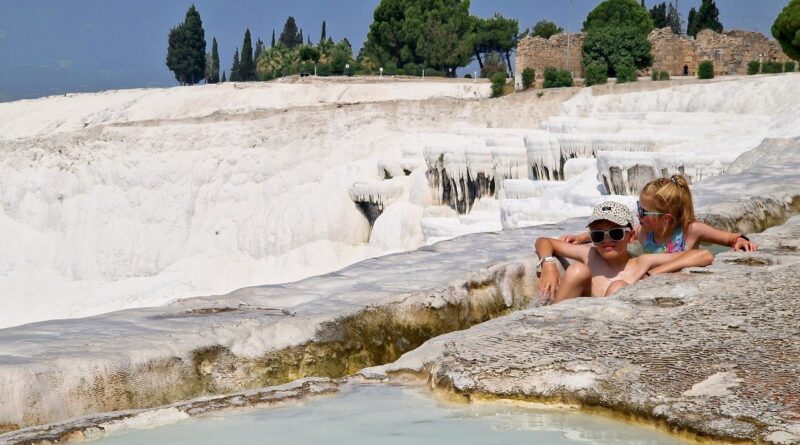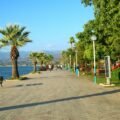A Taste of Turkey
“I’m going to tell Miss that I’ve stood on top of a real Roman column when we’re back at school,” my daughter, Ella, announces, as we lower ourselves from a semi-submerged Doric column into the bath-warm mineral waters of Cleopatra’s Pool.
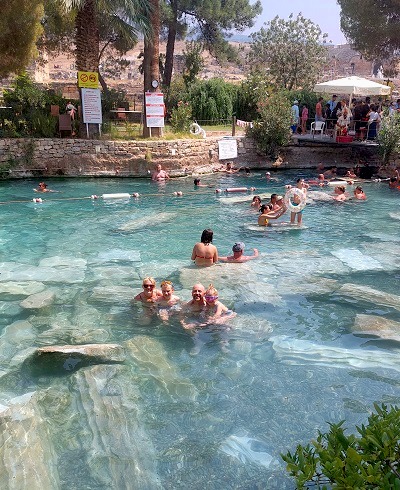 “I don’t think they’re real ones,” I tell her, as we wade past another couple of columns to our right. “They’re probably replicas, and the real ones might be in the museum.”
“I don’t think they’re real ones,” I tell her, as we wade past another couple of columns to our right. “They’re probably replicas, and the real ones might be in the museum.”
“Oh.” Ella looks disappointed. “Can we see the real ones later?”
“Sure.”
Ella and her brother Harrison spend the next hour frolicking in the crystal-clear waters, where Cleopatra and Mark Anthony also splashed around together a couple of millennia ago. I smile as I watch them, but I keep getting distracted by wondering whether these are genuine columns or not. They look and feel like marble, and I don’t think replicas would be made of real marble.
After our session ends and we’ve dried ourselves off, I make a beeline for our guide and ask her the question that’s been bothering me for the last hour.
“Yes, they’re the original columns,” she tells me. “They held a roof above the pools and were part of a temple to Apollo before they fell where they are now.”
I apologise to Ella, feeling silly that I ever doubted the authenticity of the columns. It’s not as though Turkey is short on real ruins after all. But the whole area surrounding Hierapolis – the ancient city where the pools are situated – is so surreal that it feels almost as though you’re in a dream.
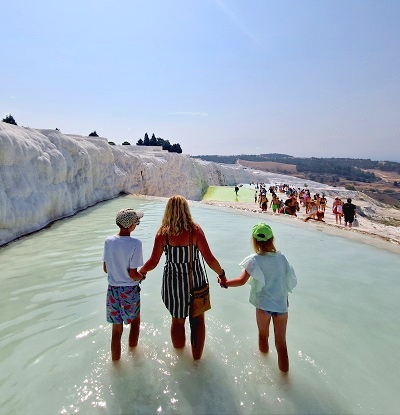 It’s not so much the ruins themselves, as the location, perched above the cotton candy-like terraces of Pamukkale, which lie around a hundred metres from the Cleopatra Pool. The name, Pamukkale, is Turkish for “cotton castle” and once you lay eyes on the oddly formed terraces it’s obvious why Pamukkale got this name. It’s an unreal landscape of petrified waterfalls, mineral forests and terraced basins filled with luxuriously warm water. It looks like nothing you’ve ever seen before, and I mean that literally. Unless of course you’ve ever been to the – far smaller – Cascate del Mulino in Tuscany, which is the only similar place on earth, and which doesn’t have the added allure of ancient ruins next door.
It’s not so much the ruins themselves, as the location, perched above the cotton candy-like terraces of Pamukkale, which lie around a hundred metres from the Cleopatra Pool. The name, Pamukkale, is Turkish for “cotton castle” and once you lay eyes on the oddly formed terraces it’s obvious why Pamukkale got this name. It’s an unreal landscape of petrified waterfalls, mineral forests and terraced basins filled with luxuriously warm water. It looks like nothing you’ve ever seen before, and I mean that literally. Unless of course you’ve ever been to the – far smaller – Cascate del Mulino in Tuscany, which is the only similar place on earth, and which doesn’t have the added allure of ancient ruins next door.
We spend another hour on the terraces paddling through the pools, toying with the white silt that lies on the bottom and watching fellow tourists making strange poses next to the calcite stalactites or sitting in a shallow river of thermal waters, which Harrison and Ella mistake for a waterslide. Everywhere there is white, and sunlight reflects from it in strange ways, washing out colours as it does so. Then it’s time to move on and explore some of the ancient city of Hierapolis, which is around a 10-minute walk away from the terraces.
Most package tourists who holiday in the Turkish resort of Kusadasi – where we are based – visit a different ancient city – Ephesus, and for good reason. It’s the best preserved and most impressive example of a Greco-Roman city in the world, with only Pompei giving it a run for its money. Plus, it’s exceptionally close to the resort of Kusadasi. But only a fraction of those visitors venture as far away as Hierapolis and Pamukkale, 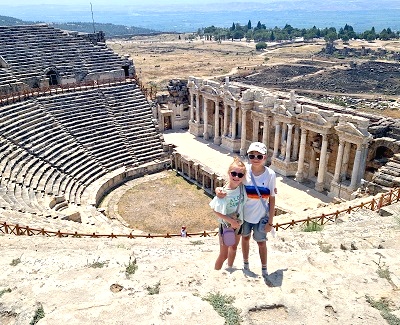 which are two and a half hours from Kusadasi by road. For me, Pamukkale and Hierapolis are even more impressive than Ephesus, and the 12,000-seater Roman amphitheatre that sits just above Cleopatra’s Pool is the icing on the cake.
which are two and a half hours from Kusadasi by road. For me, Pamukkale and Hierapolis are even more impressive than Ephesus, and the 12,000-seater Roman amphitheatre that sits just above Cleopatra’s Pool is the icing on the cake.
When we arrive at the amphitheatre, there are only around 12 other people besides ourselves. In contrast, the ruins of Ephesus felt like a rugby scrum at times, thanks to the thousands of tourists arriving on multiple cruise ships that day. Admittedly, the amphitheatre at Ephesus is more impressive – it holds 25,000 people and still hosts performances today – but the Hierapolis amphitheatre is impressive nonetheless, with spectacular views of the valleys below, as well as the other ruins of the site.
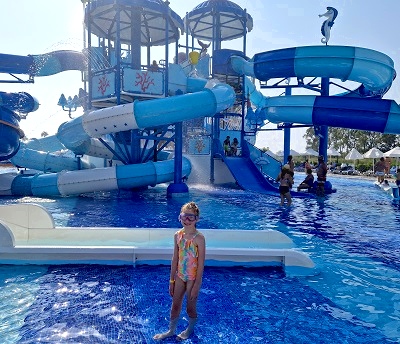 Our day trip ends with a late lunch and another swim in more thermal pools at a nearby hotel, this time with brown stalactites from the mineral deposits as our backdrop. Then we head back to our hotel in Kusadasi. It will take another two and a half hours and by the time we return the onsite waterpark – a common feature at resorts in Kusadasi – will be closed. The kids aren’t happy when they realise this, as they’ve been hurtling down the slides nonstop for the last few days, but I remind them that they’ve been in three pools unlike any in the world today, and they nod in acknowledgment before settling down on the coach. They’re already looking forward to 10am the following day, when they can frolic to their hearts content in more modern surroundings again.
Our day trip ends with a late lunch and another swim in more thermal pools at a nearby hotel, this time with brown stalactites from the mineral deposits as our backdrop. Then we head back to our hotel in Kusadasi. It will take another two and a half hours and by the time we return the onsite waterpark – a common feature at resorts in Kusadasi – will be closed. The kids aren’t happy when they realise this, as they’ve been hurtling down the slides nonstop for the last few days, but I remind them that they’ve been in three pools unlike any in the world today, and they nod in acknowledgment before settling down on the coach. They’re already looking forward to 10am the following day, when they can frolic to their hearts content in more modern surroundings again.
Practicalities
Kusadasi is a popular area on the Aegean, with dozens of high-quality resorts. All-inclusive resorts are particularly popular, some of which are more geared to adults and others to families. We stayed at the Palm Wings Ephesus, which had three large swimming areas – including an adults-only pool and a fantastic waterpark. There were also a first-class beach and water sports centre, seven bars and beautifully manicured gardens with roaming peacocks.
Trips to Pamukkale can be booked locally in Kusadasi or – for added peace of mind – with TUI. Our trip cost £84 per adult and included travel, entry to the ancient city of Hierapolis, a swim in Cleopatra’s Pool, entrance to the “cotton castle” terraces and dinner, sand entrance to thermal pools in a five-star hotel.

